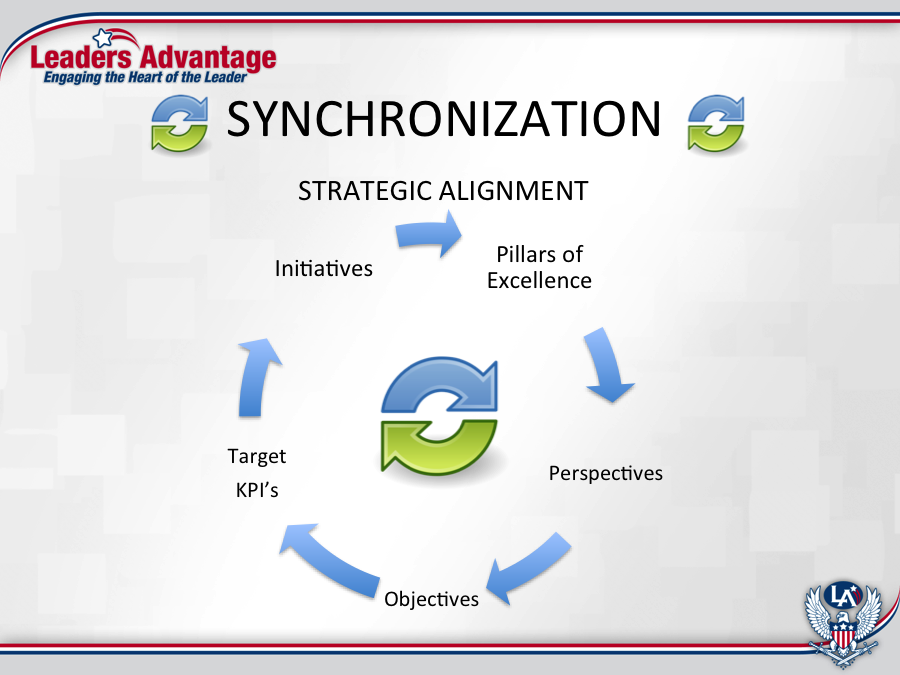A unified direction with the blueprint to execute – Synchronization
Finally, the team comes together to craft an organic map for the heart of the organization. This component of the process combines the compelling purpose, critical for helping all team members to understand “who we are”, “where the business is going”, “what we really stand for”,” how we are going to get there” and, “how each team member fits in the process” with the synchronization of this unified effort in executable form.
[su_spoiler title=”Define – Synchronization” class=”my-custom-spoiler” open=”yes”] Just as the smooth operation of very complex mechanical systems rely on a synchronized flow, that similar synchronization must develop organizationally. The process by which the leadership of an organization sets the ultimate course of direction with definable, measurable, executable steps resulting in unified accomplishment and success = SYNCHRONIZATION! [/su_spoiler]
[su_spoiler title=”Build – The Synchronized Structure” class=”my-custom-spoiler”]1. ORGANIZATIONAL ASSESSMENT
a. Key Elements:
b. Begin Synchronization
c. Analyze the organization internally and externally
d. Create a change management plan
e. Communicate the commitment to performance-based management
2. STRATEGY
a. Key Elements:
b. Choose Perspectives
c. Develop the Customer Value Proposition
d. Develop Strategic Themes and Strategic Results
3. OBJECTIVES
a. Key Elements:
b. Develop Strategic Objectives
c. Capture objective commentary (short paragraph on what is included and not included in each objective)
d. Place Strategic Objectives into Strategic Themes and Perspectives
4. STRATEGY MAPS
a. Key Elements:
b. Link Strategic Objectives in cause-effect relationships, to show the value chain to customers
c. Create an enterprise-wide Strategy Map
5. PERFORMANCE MEASURES
a. Key Elements:
b. Develop one or more Performance Measures for each objective
c. Set expected targets and thresholds for each measure
d. Complete the Data Definition Table™
e. Develop baseline data for each Performance Measure
6. STRATEGIC INITIATIVES
a. Key Elements:
b. Potential new Strategic Initiatives
c. New Strategic Initiative attributes, including: cost, timing, benefits, strategies and objectives supported, risk, earned value, prioritization criteria, and recommendations
7. CASCADE
a. Key Elements:
b. Communicate synchronization plans throughout the organization
c. Align organizational components
d. Build aligned initiatives for strategic business units and support units
e. Build aligned synchronization for teams and individuals
f. Develop performance incentives, rewards, and recognition plans
8. EVALUATIONS
a. Key Elements:
b. Hold formal reviews of the results achieved (by Strategic Themes and by Perspectives)
c. Review Strategy and Strategic Objectives; revise as necessary
d. Update performance measures to reflect learning
e. Modify Strategy, Strategic Objectives, Strategy Map, Performance Measures, and Strategic Initiatives as necessary
[/su_spoiler]
[su_spoiler title=”Design – Synchronized Flow” class=”my-custom-spoiler”] [/su_spoiler]
[/su_spoiler]
[su_spoiler title=”Measure – Targets and KPI's” class=”my-custom-spoiler”]What Are Key Performance Indicators (KPI) ?
Key Performance Indicators, also known as KPI’s, help an organization define and measure progress toward organizational objectives and goals.
Once an organization has set its vision for the future and hammered out its mission, with goals and objectives, it needs a way to measure progress toward those goals. Key Performance Indicators are those measurements.
Key Performance Indicators are quantifiable measurements that reflect the critical success factors of an organization. They will differ depending on the organization.
• A business may have as one of its Key Performance Indicators annual revenue objectives or number of new clients added to meet projected company growth.
• A school may focus its Key Performance Indicators on graduation rates of its students or trends in standardized test performance.
• A Customer Service Department may have as one of its Key Performance Indicators, in line with overall company KPIs, percentage of customer calls answered in the first minute.
• A Key Performance Indicator for a social service organization might be number of clients assisted during the year or reduction in recurring abuse in a given area.
Whatever Key Performance Indicators are selected, they must reflect the organization’s goals and objectives. They must be key to its success and they must be quantifiable (measurable). Key Performance Indicators usually are long-term considerations. The definition of what they are and how they are measured does not change often. The values for a particular Key Performance Indicator may change as the organization’s goals change, or as it gets closer to achieving a goal.
If a Key Performance Indicator is going to be of any value, there must be a way to accurately define and measure it.
It is also important to define the Key Performance Indicators and stay with the same definition from year to year.
How are targets determined and applied ?
During the synchronization process an organization will reduce its vision and mission to Key performance Indicators. The Leadership Team will then begin to develop objectives across a three-dimensional model with Strategic Themes and quantifiable Perspectives – Financial, Customer, Capacity and Process.
There will also be targets set for each Key Performance Indicator. These “targets” will be quantifiable and measurable. When the initiatives are developed and assigned, the respective individuals responsible for each initiative will have targets that will define the completion of the assignment. There may be dollar values, performance measurements, tactical standards or customer satisfaction percentages involved in the target values.
[/su_spoiler]
[su_spoiler title=”Execute – Cascade Initiatives” class=”my-custom-spoiler”]CASCADE
a. Key Elements:
b. Communicate synchronization plans throughout the organization
c. Align organizational components
d. Build aligned initiatives for strategic business units and support units
e. Build aligned synchronization for teams and individuals
f. Develop performance incentives, rewards, and recognition plans
Results:
• Buy-in and commitment expanded
• Organizational alignment continued
• Work Plans for business and support
units, and teams and individuals developed
• Incentives/rewards program implemented
• Necessary organization structural issues discussed [/su_spoiler]
[su_spoiler title=”The Expected Result” class=”my-custom-spoiler”]Upon completion of the three steps in the Enterprise Alignment, a synchronized battle plan will emerge in the following format: [/su_spoiler]
[/su_spoiler]
